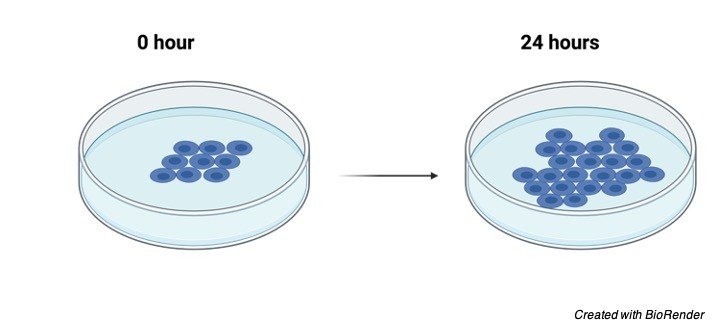What is Cell Proliferation?
Cell proliferation is defined as the increment in cell count resulting because of cell division. It is a complex, firmly controlled, clear cut cycle.
The mechanisms of normal cell proliferation, just as the pathologic outcomes happening when the system malfunctions, are basic to numerous spaces of medication, from embryogenesis, to repair of tissues, and finally to oncogenesis.

Cell Proliferation and Tissue Type
Firstly, few tissues contain cells that, previously terminally differentiated, are impotent to return the cell cycle. These tissues are known as nondividing tissues; a common representative is neural tissue.
Secondly, different tissues, like liver tissue, contain cells that typically live external the cell cycle, however which can be stimulated to multiply when needed. These tissues are called stable tissues.
Thirdly, the tissue type is named consistently dividing tissue, is persistently being supplanted because of continuous cell sloughing or cell demise. Skin and bone marrow are instances of this sort of cell.
Mechanism of Cell Proliferation
Cell division
Cells attempt the interaction of division by advancing through an exceptionally directed cycle called as the cell cycle, the end product being a duplication of the substance of the mother cell into two daughter cells.
The cell cycle was found by Prevost and Dumas (1824) while considering the cleavage of zygote of Frog.
It is a progression of stages a cell goes through, to divide and give rise to new cells.
Phases of Cell Division
Cell cycle or cell division alludes to the series of occasions that occur in a cell prompting its development and resulting division. These occasions incorporate duplication of its genome and synthesis of the cell organelles followed by division of the cytoplasm.
A commonplace eukaryotic cell cycle is separated into two primary phases:
i. Interphase
Otherwise called the resting period of the cell cycle; interphase is the time during which the cell gets ready for division by going through both cell development and DNA replication.
It involves around 95% time of the general cycle. The interphase is categorised into three phases:

• G1 phase (Gap 1): G1 phase is the period of the cell among mitosis and commencement of replication of the genetic material of the cell. During this phase, the cell is metabolically dynamic and keeps on developing without recreating its DNA.
• S phase (Synthesis): DNA replication happens during this phase. In the event that the underlying amount of DNA in the cell is signified as 2N, then, at that point after replication it gets 4N. The centriole additionally isolates into two centriole sets in the cells which contain centriole.
• G2 phase (Gap 2): During this phase, the RNA, proteins, different macromolecules needed for augmentation of cell organelles, spindle formation, and cell development are delivered as the cell plans to go into the mitotic stage.
A few cells like heart cells in the grown-up creatures don’t display division and some others just separation to supplant those cells which have been either harmed or lost because of cell death.
Such cells which don’t divide further achieve an idle G0 stage otherwise called quiescent phase after they leave the G1 stage.
These cells remain metabolically dynamic however don’t divide except if called upon to do as such.
The cycle of interphase comprises of;
| Steps | Phases | Events |
| 1 | G0 Phase (Resting Phase) | The cell neither divides nor sets itself up for the division. |
| 2 | G1 Phase (Gap 1) | The cell is metabolically dynamic and develops consistently during this phase. |
| 3 | S phase(Synthesis) | The DNA replication or synthesis happens during this phase. |
| 4 | G2 phase (Gap 2) | Protein synthesis occurs in this phase. |
| 5 | Quiescent phase (G0) | The cells that don’t undergo additional division leaves the G1 phase and enters a latent phase. This stage is known as the quiescent phase (G0) of the cell cycle. |
ii. M Pahse
This is the mitotic phase or the period of the equational division as the cell goes through a total rearrangement to bring forth a descendant that has similar number of chromosomes as the parent cell.
Different organelles are additionally separated similarly by the cycle of cytokinesis which is gone before by mitotic nuclear division.
The mitotic stage is separated into four overlapping stages:
1. Prophase
2. Metaphase
3. Anaphase
4. Telophase
Types of Cell Division
1. Mitosis: In this process, cells precisely replicates themselves. It is generally seen in multicellular organism possessing varying degree of cells.
For instance, cells of nerves, muscle, skin, hair, etc.
2. Meiosis: These are the cell division wherein sperm or egg cells are produced which contain half the number of chromosomes.
3. Binary Fission: Single celled micro-organisms duplicate themselves for precreation.
The phases of cell division and the transitions between the phases are co-ordinated by a multifaceted sequence of signalling mechanism.
At the point when the lost tissue is supplanted, the cells get back to the regular quiescent state, in this way restoring the cellular organ and tissue homeostatic systems.
Cell Proliferation and Stem Cells
The characterizing properties of a stem cells are
(1) The capacity to separate essentially unbounded all through the lifetime of the organic entity
(2) The capacity to divide symmetrically (prompting two terminally separated cells) or asymmetrically (bringing about one undifferentiated cell and one terminally separated cell).
Stem cells are required any place there is a repetitive need to supplant nondividing, terminally separated cells.
Some terminally differentiated cells, for example, develop mammalian red blood cells and the cells in the peripheral layer of the skin, do not have a cell nucleus and are accordingly incapable to isolate.
Some other contains cytoplasmic structure, (for example, the myofibrils of striated muscle cells) that obstruct cell duplication. Also, in some terminally separated cells, the science of separation may just be contradictory with cell division.
Stem cells that bring about just one type of differentiated cell are known as unipotent; these are equipped of differentiating along only single lineage. Also, few cell types are known as oligopotent. These stem cells can separate to differentiate into a couple types of cells.
A lymphoid stem cell is another sample of an oligopotent stem cell.
Cells that about numerous cell types are known as pluripotent or totipotent. However, there is different type of stem cell that is known as multipotent.
These cells are ancestor cells that have the genetic capability to differentiate into numerous, but restricted cell types.
Cell Proliferation and Cancer
Cells inside a tissue apply an inhibitory impact on one another’s development.
This limiting force is known as social control of cell division, and it is interceded by a set of genes called social control genes.
A cell that gets a DNA mutation that disrupts this social limitation will divide regardless of the necessities of the organism in general, and its offspring may become tumor cells.
Summary of Cell Proliferation
Maybe carefully incited suppression of pathways associated with cell passing and incitement of pathways associated with cell division that re-establish organ structure and function.
With the approach of gene therapy, explicit genes could, at some point, be conveyed straightforwardly to the damaged organ to incite articulation/concealment of the fitting variables required for recovery.
Cell Proliferation Citations
- Cell Proliferation and Cytotoxicity Assays. Curr Pharm Biotechnol . 2016;17(14):1213-1221.
- CXXC4 mediates glucose-induced β-cell proliferation. Acta Diabetol . 2020 Sep;57(9):1101-1109.
- Targeting mitosis exit: A brake for cancer cell proliferation. Biochim Biophys Acta Rev Cancer . 2019 Jan;1871(1):179-191.
- Mathematical models of tumor cell proliferation: A review of the literature. Expert Rev Anticancer Ther . 2018 Dec;18(12):1271-1286.
- Quantification of epithelial cell proliferation, cell dynamics, and cell kinetics in vivo. Wiley Interdiscip Rev Dev Biol . 2017 Jul;6(4).
- Tight Junctions in Cell Proliferation. Int J Mol Sci . 2019 Nov 27;20(23):5972.
- Regulation of cell proliferation by hypoxia-inducible factors. Am J Physiol Cell Physiol . 2015 Dec 15;309(12):C775-82.
Share









